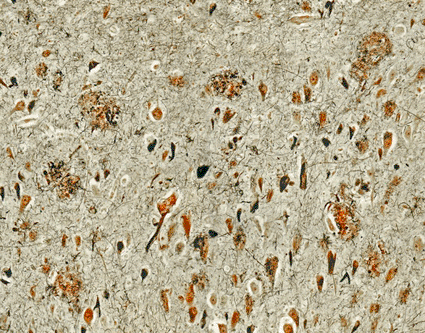Malfunctioning Transport Protein Causes Plaque Buildup in Alzheimer's Disease
By LabMedica International staff writers
Posted on 21 Jul 2009
A malfunction in the network of cells that forms the blood brain barrier allows the toxic buildup of amyloid plaque that characterizes Alzheimer's disease.Posted on 21 Jul 2009
Investigators at the Saint Louis University School of Medicine (MO, USA) worked with a mouse model of human Alzheimer's disease to study the action of low-density lipoprotein receptor related protein-1 (LRP-1), the major brain-to-blood transporter of amyloid-beta proteins at the blood-brain barrier (BBB). For this purpose, they developed specific antisense RNA to block the synthesis of LRP-1 and thereby deplete it from the cells of the BBB.

Image: Light micrograph of Alzheimer’s disease brain tissue, showing neurofibrillary tangles and amyloid plaques (Photo courtesy of Thomas Deerinck, NCMIR / SPL).
Results of this study, published in the July 2009 issue of the Journal of Alzheimer's Disease, revealed that these antisense RNAs in comparison to random antisense RNA selectively decreased LRP-1 expression, reduced BBB clearance of amyloid-beta protein, increased brain levels of amyloid-beta protein, and impaired learning ability and recognition memory in mice.
Having confirmed the importance of LRP-1 in transporting amyloid-beta protein out of the brain, the investigators looked at the factors that could affect LRP-1's ability to function. They reported in the May 2009 issue of the journal Brain Behavior and Immunity that inflammation was directly linked to the malfunction of LRP-1. They induced inflammation in the brains of mice with lipopolysaccharide (LPS) and found that inflammation increased brain levels of amyloid-beta protein by three mechanisms: increased influx, decreased efflux, and increased neuronal production.
Treatment of the mice with the anti-inflammatory drug indomethacin prevented inhibition of LRP-1 and tended to lower the concentration of amyloid-beta protein in the brains of the animals.
"We induced inflammation in mice and found that it turned off the LRP pump that lets amyloid-beta protein exit the brain into the bloodstream. It also revved up an entrance pump that transports amyloid-beta into the brain. Both of these actions would increase the amount of amyloid-beta protein in the brain," said senior author of both papers Dr. William A. Banks, professor of geriatrics and pharmacological and physiological science at the Saint Louis University School of Medicine. "Nonsteroidal anti-inflammatory drugs, especially indomethacin, have been associated with protection against Alzheimer's disease. Our work could influence that debate and thinking at the patient-care level."
Related Links:
Saint Louis University School of Medicine













